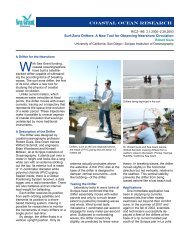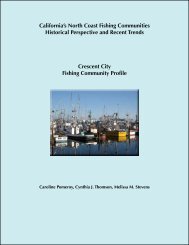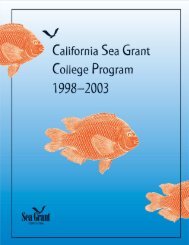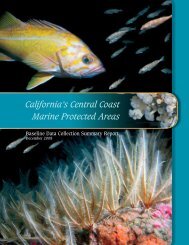2001â2002 - California Sea Grant - UC San Diego
2001â2002 - California Sea Grant - UC San Diego
2001â2002 - California Sea Grant - UC San Diego
Create successful ePaper yourself
Turn your PDF publications into a flip-book with our unique Google optimized e-Paper software.
<strong>Sea</strong> <strong>Grant</strong> Responds to Invasive <strong>Sea</strong>weed Caulerpa taxifolia<br />
Caulerpa Be Gone…<br />
According to the most recent<br />
survey of the Agua Hedionda<br />
Lagoon in Carlsbad, the Caulerpa<br />
infestation has shrunk from a peak<br />
of about 11,000 square feet to<br />
about 4 square feet. This is a<br />
dramatic reduction but not the end<br />
goal of total eradication.<br />
“It is like a house on fire,” said<br />
Carlsbad senior planner Eric<br />
Muñoz, the city’s liaison to the<br />
Southern <strong>California</strong> Caulerpa<br />
Action Team, a multi-agency group<br />
that is leading the eradication<br />
effort. “The flames are gone, but<br />
the house is still smouldering.<br />
Likewise, the eradication is not<br />
done.”<br />
In terms of <strong>Sea</strong> <strong>Grant</strong>’s role in<br />
the Caulerpa eradication effort,<br />
Muñoz said: “I see <strong>Sea</strong> <strong>Grant</strong> as a<br />
credible interface between the<br />
world of science and the resource<br />
agencies. <strong>Sea</strong> <strong>Grant</strong> is a vital part<br />
of explaining the problem, communicating<br />
the solution and<br />
keeping stakeholders updated.”<br />
C<br />
aulerpa taxifolia is a bright green, feathery seaweed, infamous<br />
for destroying huge tracts of habitat on the bottom of the<br />
Mediterranean <strong>Sea</strong>. The seaweed grows quickly, is hearty and attractive—traits<br />
that make it both an ideal plant for aquaria and an extremely difficult<br />
one to eradicate once established in the wild. The first documented patch of<br />
Caulerpa in the Mediterranean was identified around 1984. Tests later showed<br />
the plants were clones of ones cultured for display at the Stuttgart Aquarium in<br />
Germany and shared with aquaria in France and Monaco. That initial patch,<br />
about one-square meter in size, spread faster and farther than anyone could have<br />
then imagined, covering everything—sand,<br />
gravel and boulders—in a feathery green<br />
monoculture, comparable to a living carpet of<br />
Astroturf.<br />
Today, more than 32,000 acres of the<br />
seabed from Tunisia to Croatia are covered in<br />
a vast Caulerpa monoculture, a rolling<br />
meadow of one foreign toxic plant, providing<br />
neither habitat nor food for native marine life.<br />
Fishing, recreational diving, tourism and<br />
marine life have all suffered. Eradication is no<br />
longer a discussed possibility. Scientists speak<br />
of trying only to control the seaweed’s steady<br />
march. Caulerpa, along with species such as<br />
zebra mussels, are held up as case-in-point<br />
reasons for gathering international support for<br />
preventing the further introduction and<br />
spread of nonindigenous species.<br />
In June of 2000, much to the dismay of<br />
biologists, Caulerpa was found in North<br />
America for the first time, in two lagoons in<br />
Southern <strong>California</strong>, at the Agua Hedionda<br />
Lagoon in Carlsbad and in Huntington<br />
Harbour in Orange County. Recognizing the<br />
An aerial view of the Agua Hedionda Lagoon in<br />
Carlsbad, <strong>California</strong>. Caulerpa has infested two sites<br />
in North America, both in Southern <strong>California</strong>. The<br />
infestation at the lagoon is of particular concern<br />
because the waterway is connected to the open<br />
ocean. Photo: City of Carlsbad<br />
15











